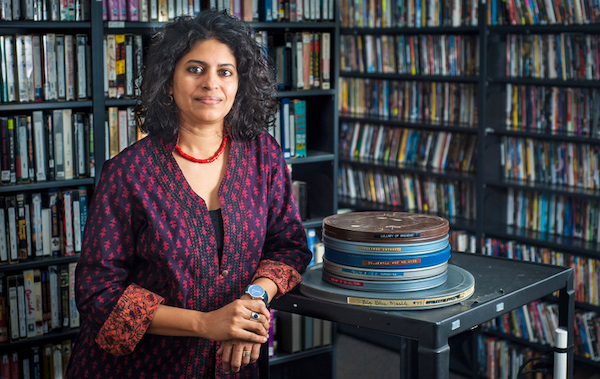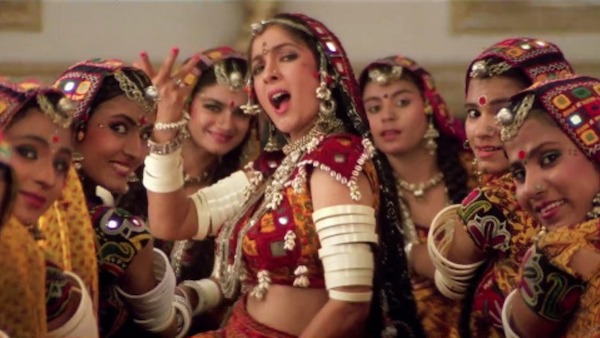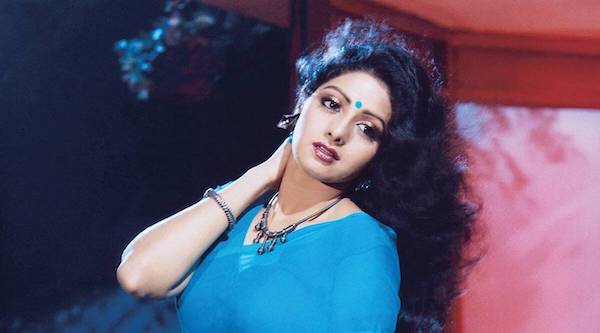Let’s be honest, who amongst us hasn’t enjoyed shimmying to the latest “item number” from Bollywood be it as part of a ‘baraat’, at a club or even as part of a festival celebration. Dance numbers are iconic to Bollywood, with the Hindi film industry churning out a dozen or more dance-based songs yearly, some becoming the latest musical rage.
Sitting at her desk, with the sun streaming in, wearing a colorful Indian patterned kurta, Dr. Usha Iyer, Assistant Professor of Film and Media Studies at Stanford University’s Art and Art History Department makes for a perfect Saturday morning conversation about her latest book “Dancing Women – Choreographing Corporal Histories of Hindi Cinema,” a deep dive into the material and cultural production of dance in Bollywood.
Hindi cinema and dance exist in a symbiotic relationship. Be it the beautiful Vyjayanthimala or the sultry vamp Helen in the 1950s to Sridevi and Madhuri Dixit in the 1990s, the dancing stars have had a strong influence on the material and cultural production of Hindi films – with an entire industry developing around it.
Speaking to American Kahani about this and more, Iyer starts off with how the idea for the book came about. “It started during my PhD years,” says Iyer, who grew up in Mumbai and came to the University of Pittsburgh to pursue her advanced degree. “I had planned to study European cinema – Polish and Swedish cinema in particular. But everyone around me kept encouraging me to work on Indian cinema because since the ’90s study of Indian cinema has become a big thing.” Iyer’s love for Hindi film song-and-dance sequences, “growing up on a steady diet of ‘Chayageet’ and ‘Chitrahaar’ in the 1980s” found her coming back to Indian cinema, “no matter what I wrote about.”

Growing up in a household where her father, a devoted cinephile and lover of old Bollywood songs, influenced Iyer greatly. “That was the soundtrack of my mind when working on this book.” She adds laughing, “You mention the word Bollywood to anyone across the globe and the first thing they think of is one of the big budget song and dance numbers.”
When she entered her PhD, Iyer discovered that although “Indian cinema studies had become quite mature and so there were a lot of excellent books out there already focusing on the masala film form, “there was very little scholarship” on dance. But she wanted to consider “the less-examined impact of dance not just on the Hindi film narrative but on questions of labor, training, and expertise, which in turn would shine a light on the various bodies that work to produce the final spectacle of Hindi film dance.”
Iyer did face little familial resistance. Coming from an upper-caste, middle class family in India, “they don’t encourage you to work on Hindi films,” she says. However, she persisted and continued her work. “As with most academic books, it took a long time to complete” – starting nearly nine years ago when she began research for her PhD dissertation.
Memoirs and Autobiographies

Speaking about her extensive research for this book, Iyer says, “I turned to a variety of sources” like memoirs and autobiographies “to piece together these histories of Hindi cinema’s dancing women.”
I looked at memoirs and autobiographies of Sadhona Bose, Modhu Bose, Vyjayanthimala, Waheeda Rehman, Helen, journalistic reports, song booklets at the National Film Archives of India and at the British Library’s Endangered Archives, films and TV shows (like The Saroj Khan Story, Baaje Payal etc), Doordarshan and Sangeet Natak Akademi archives, among others.”
In Indian cinema, women were the primary performers of dance until the late 1990s when Shah Rukh Khan stormed the dance scene with ‘Chaiyya Chaiyya. Speaking of the sexualization and gender component to these dances, Iyer talks about how the audience would react to these “production numbers,” where the woman looks out at the audience. “People would dance in the aisles and throw coins at the screen. There would be all kinds of embodied physical responses to these dance numbers,” she says and adds: “And I wondered why a feminist like me still enjoyed watching them.”
Breaking the mindset down further, Iyer says, “Not just men, but women too take a lot of pleasure from these numbers as well. And that is really when we begin to complicate the issue – why do we have to center the male gaze in explaining our pleasure?”
With previous work having been done on women as the passive object of erotic desire, Iyer had to turn to dance studies to understand the amount of training these women had to do to perform these numbers.
For Iyer, there were “two ways of thinking about this pleasure we derive – queer pleasure being one of them. Why do I enjoy them, “ she wonders, and addds, “It’s not only a heterosexual male gaze. It’s a whole gamut of other pleasures and also the pleasure of the performer. They love doing these complex numbers.”
And to understand this pleasure, Iyer interviewed yesteryear year actresses Waheeda Rehman and Madhuri Dixit in person. She said the interview was “very illuminating as our stars are rarely asked questions about how much they trained and rehearsed for a particular hit song, or the specifics of their collaboration with cinematographers, choreographers, costume and set designers, music composers etc.”
Iyer says, “They were delighted to be asked about their work rather than the routine questions about rumored liaisons and the like. Their faces lit up as they remembered especially complex dance moves and as they recounted the extensive labor of everyone on a film set engaged in producing a dance number.”
Iyer also divulges that the sexy “Choli Ke Peeche” song picturized on Madhuri Dixit and Neena Gupta was a favorite of Dixits, despite the societal outrage and censorship battles it had caused. “Madhuri talked of how she and choreographer Saroj Khan devised this move where she would lift her leg in her ghagra and twist her ankle and told me how much she loved learning that step,” says Iyer adding, “For me the book became about the pride, joy, training, labor (of heroines, backup dancers and choreographers etc.) and virtuosity of the women who were performing these dances.”
In order to do this effectively, Iyer took up dance training for the first time ever, learning Odissi with Guru Rashmi Ranjan Jena at the Triveni Kala Sangam in Delhi. “Only through the lived experience of sharply aching legs, and recognizing the hours of practice required to capture the nuance of a mudra (gesture), or the years of training it would take to perfect a glance or a neck movement, did I come to appreciate that issues of training, rehearsal, and virtuosity would be central to my examination of the legacies of dancing women.”

Item Numbers
Speaking to the development of the industry, and the term ‘item number’ being a recent phenomenon of the industry, Iyer says: “The vamps always did these dance numbers, but even the heroines like Vyjayanthimala or Sharmila Tagore, really enjoyed doing these.” Similarly, she notes that music composers, like RD Burman, “who specialized in these numbers,” had to pick singers like “Geeta Dutt or Asha Bhonsle who had the voices for these songs.”
“This wasn’t a mere production on the side – quick and cheap – to address the salacious male gaze. Everything – from carpenters, to make up artists, costume designers, set designers is way more complicated in these numbers than we give them credit for. A big percentage of a film’s budget goes into these numbers.”

Further elaborating on this complicated symbiotic relationship, Iyer explains it through a term she coined in the book – choreomusicking. “Researching dance numbers for years made it evident that it isn’t just the talent of the on-screen dancer/s and or the music that makes them so scintillating, but that many bodies trained in many aspects of filmmaking together produce the on-screen performing body. I describe this as a multi-bodied choreomusicking body that draws our attention not only to the on-screen performers’ gestures, but also to off-screen music production, art direction, costume, makeup, and other industry practices.”
Explaining further, Iyer says, “When we watch a song-and-dance sequence, we experience approximately 3-6 minutes of it on screen, but also become attuned to recognizing the process behind it simultaneously and even further, we see the years of training each of those professionals went through.”
While speaking of dance numbers, talking of music seems the next logical step. “There’s excellent scholarship on music in popular Hindi cinema, where many have said that unlike Hollywood where you have musicals as a separate genre, in which people suddenly inexplicably sing and dance,” no matter what language or genre.
Iyer attributes this to the fact that it “draws from different traditions – jatra, lavni, Parsi theatre, patachitra,” adding, “We have had long histories where music and dance are part of the storytelling, not separate entities. Popular Indian cinema is allied to the epic form – everyone knows the story, but we return to it for the beauty in which it is retold through song and dance.”
Iyer believes that most of us remember the song and dance as the “stories were often banal.” She contends that the film formula – boy meets girl, falls in love, crisis occurs and resolution of it remains the same. Iyer believes it is the song and dance sequence where the most innovation can and does occur.
The Classical and the Popular
Speaking to the new breed of dancers in comparison to the yesteryear actresses who were accomplished classical dancers in their own right like Vyajayanthimala, Madhuri Dixit, Meenakshi Sheshadri among others, Iyer says, “To be honest I love a Katrina Kaif item number as much as any of the big Vyajayanthimala numbers. The intent of the book was to collapse the divide between the classical and the popular. As the book says, middle class women started learning classical dance only by pushing out traditional hereditary performers like devadasis and tawaifs. And so we had this artificial category of ‘classical’ that was created that marginalized a lot of other kinds of women seen as ‘not respectable’. And that same language comes back now to talk of the contemporary Bollywood ‘item girl’ –scandals around them, their skimpily clad bodies etc. The heroines of the ’30s like Sadhana Bose, the “bhodro mohila” (gentle woman) and Azuri wore very skimpy clothes, so this veil of respectability that has come up is a new concept that goes back to the Independence movement and the anti-colonial movement, religion, caste and class which produced one kind of respectable woman. She was supposed to stay home, be fully covered. These are very Victorian ideas. So I don’t pitch them against each other.”
As to the training involved for modern-day dance numbers, Iyer believes, quoting the late choreographer Saroj Khan that more often than not modern day dance numbers are made on the editing table. “But if our bodies respond and want to listen to these numbers then I prefer them to any other so-called respectable number,” Iyer says.

Iyer, whose classes are popular, and draw curious students who believe they are going to “get a fun course, watching colorful movies full of bright costumes”, get a lot more than that. “They come in loving Shah Rukh Khan (“Dil Se” is one of the first movies she shows) and leave with an understanding that these movies are more complicated dealing with issues like caste, terrorism and politics, than just a fun dance number and how the songs produce an empathy for characters that may be on the fringe of society.”
As to whether we will ever live in a world without the quintessential Bollywood ‘naach gaana’ in a movie, Iyer says, “The rare instances of a serious movie, with no song and dance, like the kinds Satyajit Ray was known for, will exist. But we don’t have to choose one or the other. We are seeing more variety in films like ‘Haider,’ where the songs play in the background. But directors like Karan Johar, Sanjay Leela Bhansal, and Farah Khan are still making films in that popular idiom. Why would we want to flatten the world – making the same kind of movies?”
Iyer states with finality, “Moving outside the metropolises, the Eid release of a Salman Khan film, with its dancing and action is a very big thing. But why would we want to lose that? I want all of it to be there – having the choice to watch one kind of film one day and something totally different the next.”
Anu Ghosh immigrated to the U.S. from India in 1999. Back in India she was a journalist for the Times of India in Pune for 8 years and a graduate from the Symbiosis Institute of Journalism and Communication. In the U.S., she obtained her Masters and PhD. in Communications from The OhiThe 16-year-old New Yorker has a romance with poetry and a passion for social justice.o State University. Go Buckeyes! She has been involved in education for the last 15 years, as a professor at Oglethorpe University and then Georgia State University. She currently teaches Special Education at Oak Grove Elementary. She is also a mom to two precocious girls ages 11 and 6.



